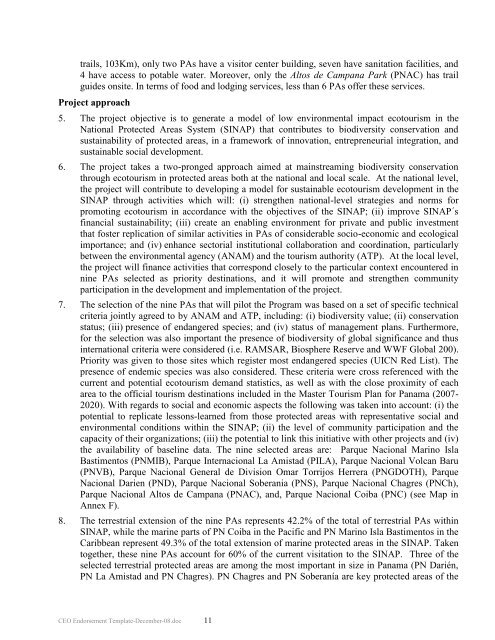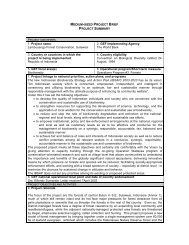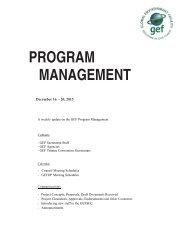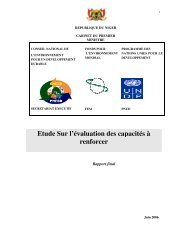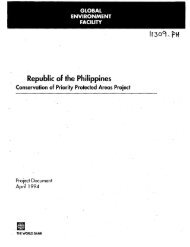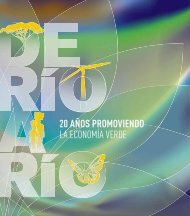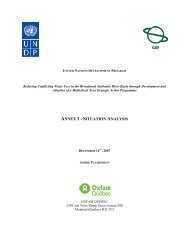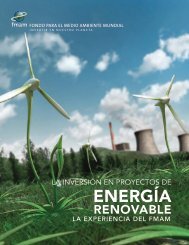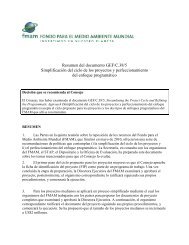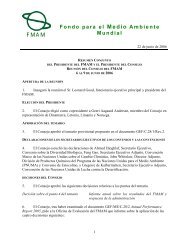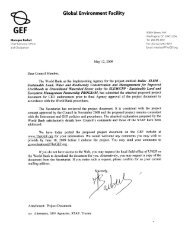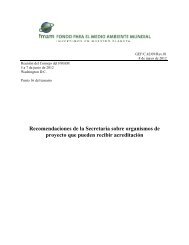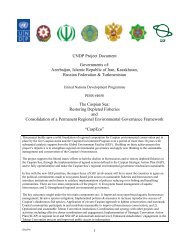English - Global Environment Facility
English - Global Environment Facility
English - Global Environment Facility
Create successful ePaper yourself
Turn your PDF publications into a flip-book with our unique Google optimized e-Paper software.
trails, 103Km), only two PAs have a visitor center building, seven have sanitation facilities, and<br />
4 have access to potable water. Moreover, only the Altos de Campana Park (PNAC) has trail<br />
guides onsite. In terms of food and lodging services, less than 6 PAs offer these services.<br />
Project approach<br />
5. The project objective is to generate a model of low environmental impact ecotourism in the<br />
National Protected Areas System (SINAP) that contributes to biodiversity conservation and<br />
sustainability of protected areas, in a framework of innovation, entrepreneurial integration, and<br />
sustainable social development.<br />
6. The project takes a two-pronged approach aimed at mainstreaming biodiversity conservation<br />
through ecotourism in protected areas both at the national and local scale. At the national level,<br />
the project will contribute to developing a model for sustainable ecotourism development in the<br />
SINAP through activities which will: (i) strengthen national-level strategies and norms for<br />
promoting ecotourism in accordance with the objectives of the SINAP; (ii) improve SINAP´s<br />
financial sustainability; (iii) create an enabling environment for private and public investment<br />
that foster replication of similar activities in PAs of considerable socio-economic and ecological<br />
importance; and (iv) enhance sectorial institutional collaboration and coordination, particularly<br />
between the environmental agency (ANAM) and the tourism authority (ATP). At the local level,<br />
the project will finance activities that correspond closely to the particular context encountered in<br />
nine PAs selected as priority destinations, and it will promote and strengthen community<br />
participation in the development and implementation of the project.<br />
7. The selection of the nine PAs that will pilot the Program was based on a set of specific technical<br />
criteria jointly agreed to by ANAM and ATP, including: (i) biodiversity value; (ii) conservation<br />
status; (iii) presence of endangered species; and (iv) status of management plans. Furthermore,<br />
for the selection was also important the presence of biodiversity of global significance and thus<br />
international criteria were considered (i.e. RAMSAR, Biosphere Reserve and WWF <strong>Global</strong> 200).<br />
Priority was given to those sites which register most endangered species (UICN Red List). The<br />
presence of endemic species was also considered. These criteria were cross referenced with the<br />
current and potential ecotourism demand statistics, as well as with the close proximity of each<br />
area to the official tourism destinations included in the Master Tourism Plan for Panama (2007-<br />
2020). With regards to social and economic aspects the following was taken into account: (i) the<br />
potential to replicate lessons-learned from those protected areas with representative social and<br />
environmental conditions within the SINAP; (ii) the level of community participation and the<br />
capacity of their organizations; (iii) the potential to link this initiative with other projects and (iv)<br />
the availability of baseline data. The nine selected areas are: Parque Nacional Marino Isla<br />
Bastimentos (PNMIB), Parque Internacional La Amistad (PILA), Parque Nacional Volcan Baru<br />
(PNVB), Parque Nacional General de Division Omar Torrijos Herrera (PNGDOTH), Parque<br />
Nacional Darien (PND), Parque Nacional Soberania (PNS), Parque Nacional Chagres (PNCh),<br />
Parque Nacional Altos de Campana (PNAC), and, Parque Nacional Coiba (PNC) (see Map in<br />
Annex F).<br />
8. The terrestrial extension of the nine PAs represents 42.2% of the total of terrestrial PAs within<br />
SINAP, while the marine parts of PN Coiba in the Pacific and PN Marino Isla Bastimentos in the<br />
Caribbean represent 49.3% of the total extension of marine protected areas in the SINAP. Taken<br />
together, these nine PAs account for 60% of the current visitation to the SINAP. Three of the<br />
selected terrestrial protected areas are among the most important in size in Panama (PN Darién,<br />
PN La Amistad and PN Chagres). PN Chagres and PN Soberanía are key protected areas of the<br />
CEO Endorsement Template-December-08.doc 11


